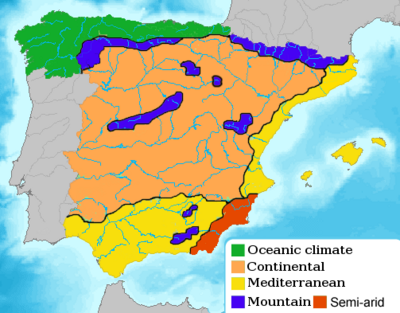The History of Spain
Spain has a long and distinctive past. This unique country has been occupied by many regimes including: the Phoenicians; the Romans; the Suevi; the Vandals; the Alans; the Visigoths; and the Arab-Muslims.
During the 1400s, Isabella of Castile and Ferdinand of Aragon, whom were Catholic Monarchs, married, thus the reign began over the Spanish Empire. However by the 1930s, the people of Spain no longer wanted a Monarchy and so The Republic was created on April 14, 1931.
The Republic was riddled with political, social and economic discord. The country would fall into a world filled with war and dictatorship which lasted over forty years. Once Dictator, General Francisco Franco died in 1975, the Monarchy government was reestablished giving way to a western-style democracy which has developed the country, and today, ranks twelfth in the world on its economy and commands the tenth highest quality of life index rating in the world.
Spain is also a member of several global organizations including: the United Nations, European Union, North Atlantic Treaty Organization, World Trade Organization and others.
Climate of Spain
 You can expect three main climate variations in Spain. If you are along the peninsula or coastal regions, it is more prone to a Mediterranean climate, with dry and very warm summers, beautiful autumns and springs and mild winters.
You can expect three main climate variations in Spain. If you are along the peninsula or coastal regions, it is more prone to a Mediterranean climate, with dry and very warm summers, beautiful autumns and springs and mild winters.
In the southeastern portion of the country where the Ebro valley and Murcia is located; the climate can be referred to as semiarid; a desert-like heat, with very hot summers and mild to warm winters.
The north quarter of the country where Cantabria, Basque Country, Asturias and portions of Galicia are located, you can expect what is known as oceanic climate; where the summer, spring, autumn and winter seasons are determined by the ocean, though you can anticipate mostly warm summers and cool winters.
Your Visa to Spain
If you are a citizen of the European Union (EU), which means the country that you maintain citizenship in, you will not be required to attain a visa to enter Spain. You are allowed to stay up to 90 days within a six month period.
 If the country that you maintain citizenship in is not a part of the EU, you will be required to attain a visa to enter Spain unless there have been special arrangements made between Spain and your home country. Your local consulate will have visa applications and can assist you with this process. You’ll need to apply for and have in hand, your visa prior to travel.
If the country that you maintain citizenship in is not a part of the EU, you will be required to attain a visa to enter Spain unless there have been special arrangements made between Spain and your home country. Your local consulate will have visa applications and can assist you with this process. You’ll need to apply for and have in hand, your visa prior to travel.
All travelers are required to carry a passport. It is recommended that you have at least two full blank pages in the visa section prior to traveling. Often times, you may have to travel through another country or region before arriving in Spain and this country may require the necessary stamps within your passport/visa section.
Also, check with your airline to determine whether or not you’ll need a transit visa. Countries that you may pass through on the way to Spain may require it.
Lastly, always check with your local consulate prior to travel to inquire about any visa updates.
Currency of Spain
 The Euro is the currency of Spain. Spain also accepts major credit cards such as your Visa, MasterCard or American Express in major stores and some restaurants – if using your credit card, there will be a surcharge, fee or rate comparable to what you would pay normally when purchasing with your card.
The Euro is the currency of Spain. Spain also accepts major credit cards such as your Visa, MasterCard or American Express in major stores and some restaurants – if using your credit card, there will be a surcharge, fee or rate comparable to what you would pay normally when purchasing with your card.
Using your ATM card in Spain will work and the fees will be comparable to exchanging currency at a bank.
If you need to exchange currency in Spain:
- any major bank will work;
- if you own an American Express card, seek out their local office; or
- if you’re looking for the best currency exchange rate, seek out reputable exchange offices which handle most currencies and usually have a better rate of exchange. The best ways to find these offices are, inquiring with your hotel concierge, or if you are traveling with a tour group reach out to your guide.
The Language
 The official language of Spain is Spanish. If you’re not already familiar with the dialect, it’s always customary to familiarize yourself with the native language of any country you’re visiting; learning main words and phrases will help you adapt and feel more comfortable during your adventure.
The official language of Spain is Spanish. If you’re not already familiar with the dialect, it’s always customary to familiarize yourself with the native language of any country you’re visiting; learning main words and phrases will help you adapt and feel more comfortable during your adventure.
It is suggested that you take a basic on-line Spanish tutorial; pick up a “how to” book or, if you’re savvy you can pick of the language once you’re in Spain, as Spanish is considered one of the easier languages to grasp, and friendly natives of the region may assist you along.
Traveling to Spain
Air travel is always the best and most economic way to travel to Spain. Always try and book a few weeks or months in advance as you are pretty much guaranteed an awesome deal.
Once you’re in Spain, you will have access to the country’s train system, buses, and taxis. Renting a car is always an option – an expensive option but it may suit you if you plan on exploring some of Spain’s regions that aren’t easily accessible by train or bus.
The largest airport in Spain is Barajas Airport in Madrid.
Cities to Visit While in Spain
- Madrid – diverse and very friendly
- Barcelona – borders France with great beaches
- Sevilla – stylish city with great cuisine and night life
- Granada – stunning gardens and Moorish palaces
- Valencia – great festivals – i.e. Las Fallas
